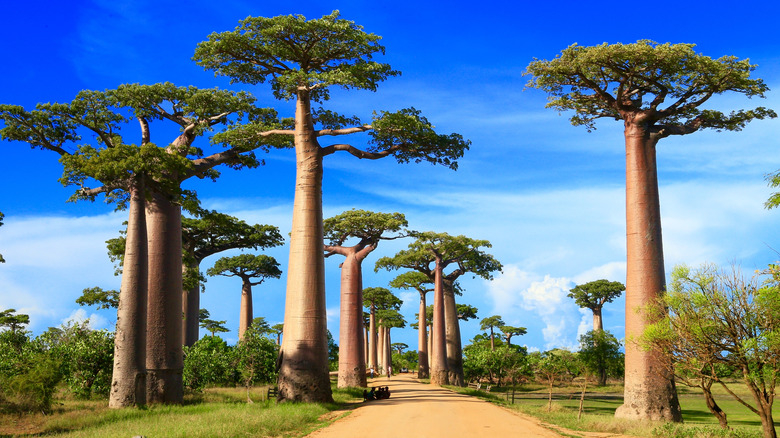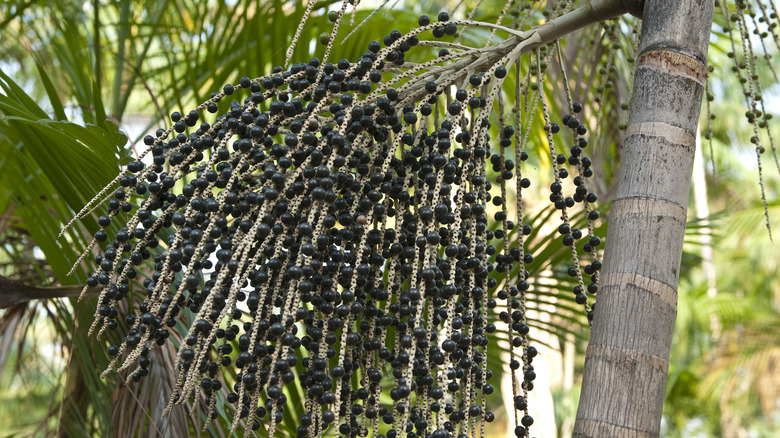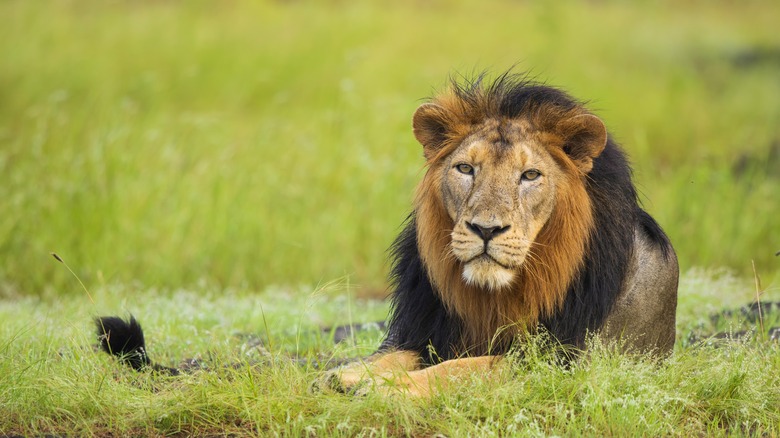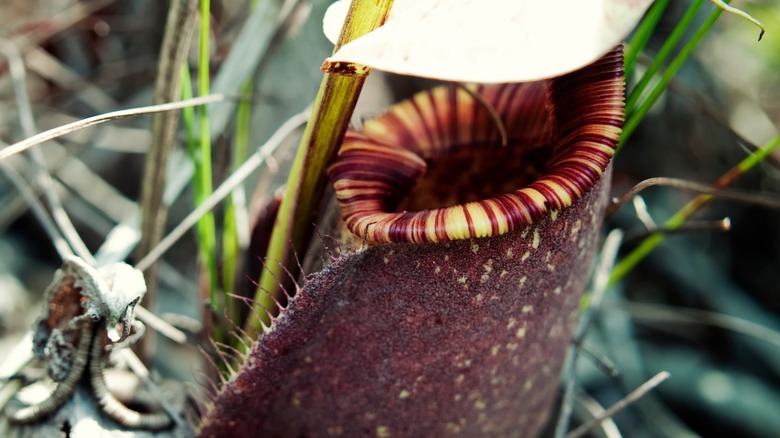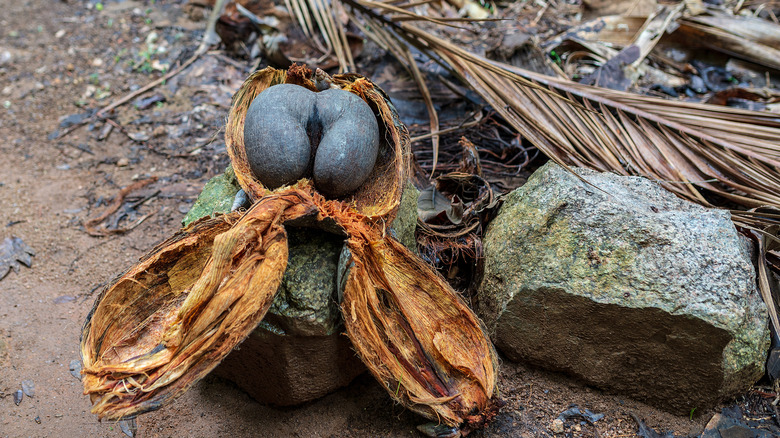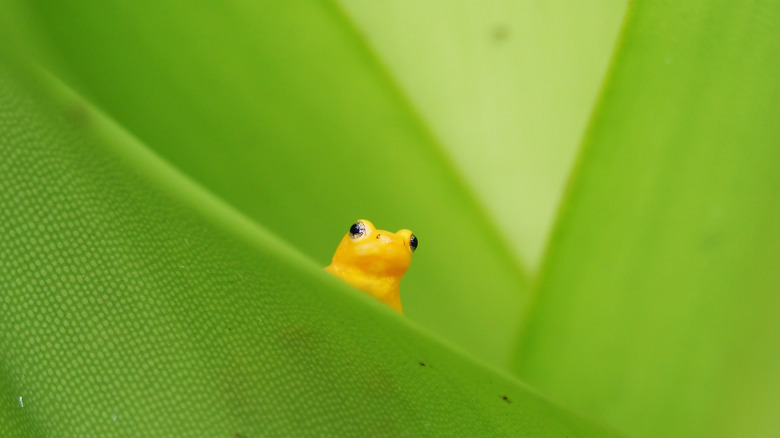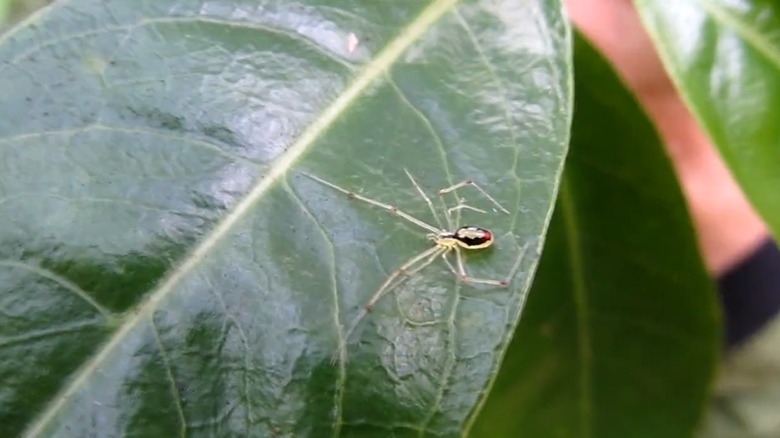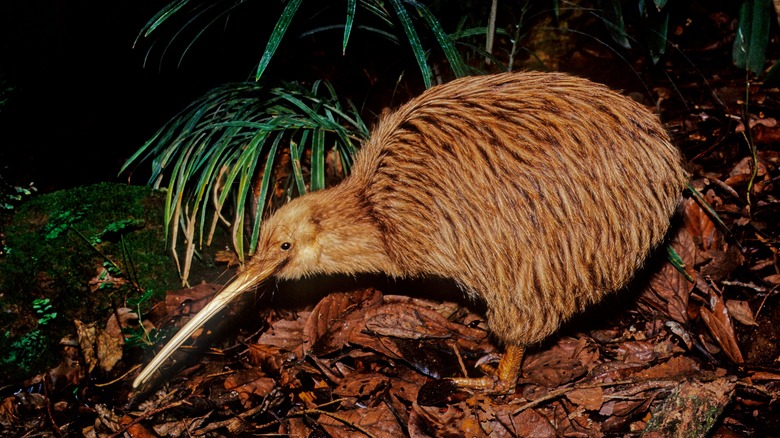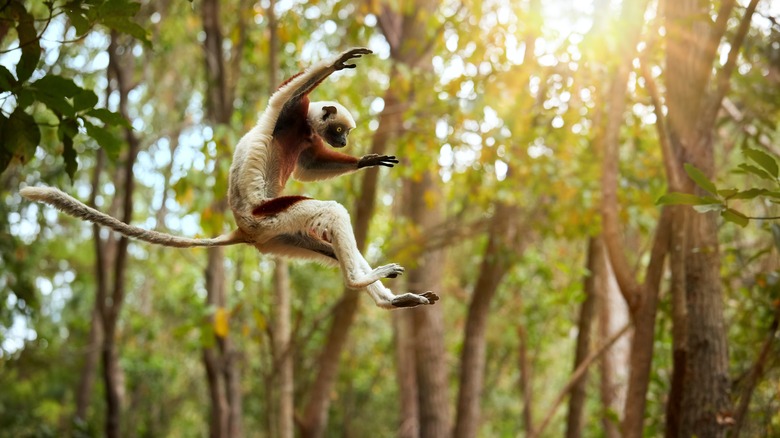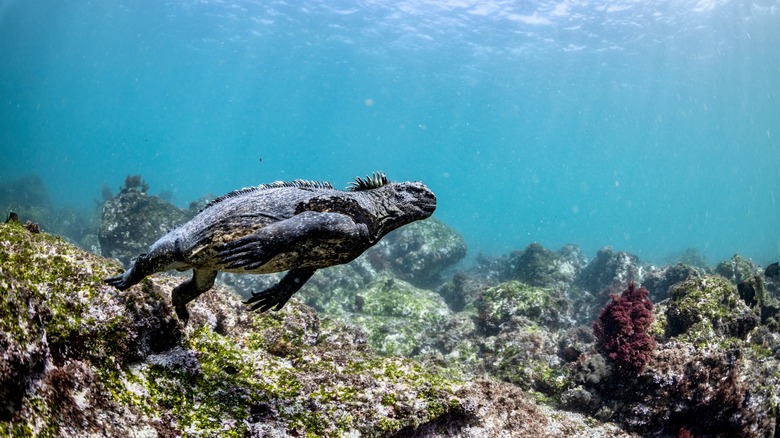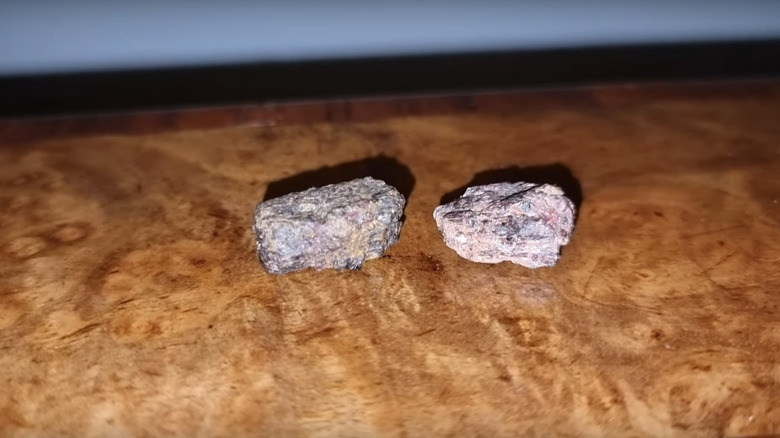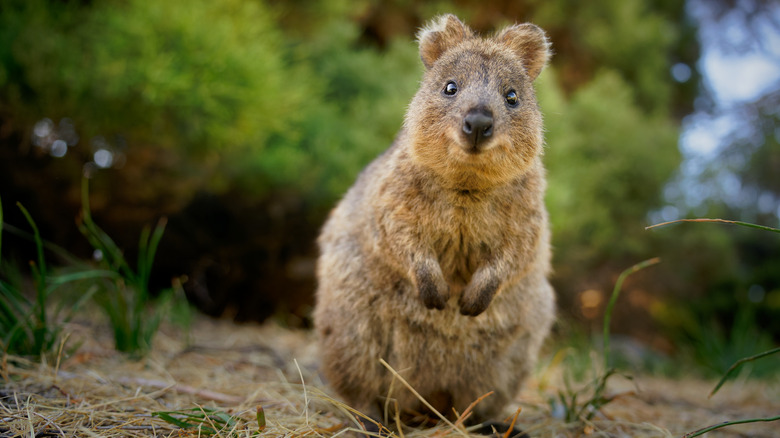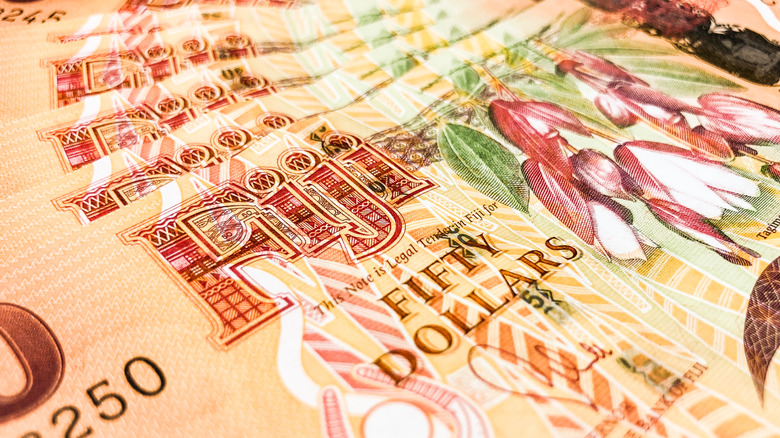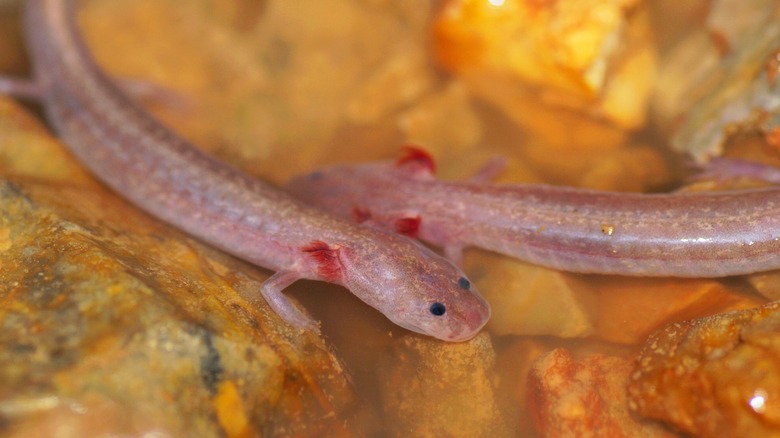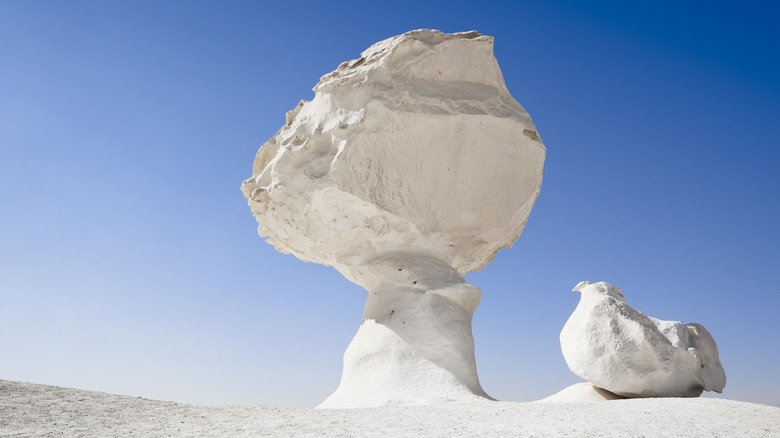15 Things You Can See At Only One Spot In The World
As travel, commerce, and technology flourish, the world becomes more homogenous. Anyone with the internet and a credit card can arrange an entire trip to a far-off part of the globe with a few clicks on a screen. Fruit and vegetables that once only grew in one part of the world now exist in multiple locations. Lychees, for example, have a history going back thousands of years. Native to Southern China, lychee trees now grow in Florida, with somewhere between 700 to 1,200 acres of the state's land devoted to the juicy fruit.
With this democratization of the planet and the ease with which we can explore its terrain, there comes a creeping sense that uniqueness has become increasingly elusive. How long before, wherever we go, it all feels same-old, same-old? Fear not, jaded travelers, we hear your call. There are still things out there that aren't visible at multiple spots around the planet or that you can't experience at any old location on Earth. The unique creatures, objects, places, and plant life we've uncovered really are one-of-a-kind, like the yellow-eyed penguins of New Zealand (or the lemurs, kiwis, and Coco de Mer, which we have personally seen). For firm believers of the maxim that variety is the spice of life, long may it stay that way!
Açaí - Amazon rainforest
Not long ago, the words "açaí bowl" weren't common in the United States. But now, diners can order this dish nationwide, from a cafe in Alaska to one on the sunny streets of Key West. A small berry that resembles a blueberry, açaí only appears in South America's Amazon rainforest. The fruit grows on skinny palm trees, which can rise about 80 feet from the rainforest floor. After the berries are picked, they have a minimal shelf life. Once taken from the tree, freezing açaí helps keep it usable. This is why they are rarely seen in their fresh form outside Brazil — as most of them come from the portion of the Amazon there.
Many people and groups have hailed açaí as a superfood for its antioxidant powers. The list of benefits these berries may convey is long and includes better skin and hair, weight loss, stronger memory function, and combating cancer. However, most of these claims require more scientific study to confirm or refute. The potential benefits have helped açaí become a fashionable ingredient in smoothies and bowls, and shoppers can often find frozen açaí sold in grocery stores.
Asiatic lion - India
This might come as a surprise, but lions exist outside Africa. No, not the mountain lions, also known as cougars, found across the Americas. We mean the type of lion sometimes called the "King of the Jungle." The Asiatic lion looks similar to its African counterpart — both sets of males have those distinctive manes. However, the Asian variety has a trimmer and darker mane, making their ears more visible. The Asiatic lion is also generally smaller and far fewer in number, with less than 1,000 still surviving.
The Asiatic lion calls a small patch in Gujarat state of western India home. They once existed in other parts of Asia, as far west as Turkey, but hunters drastically reduced their numbers. Travelers hoping to catch sight of these creatures can plan a visit to Gir National Forest. In addition to lions, visitors might spot the chousingha, the only four-horned antelope on the planet, and birds like the endangered Pallas's fish eagle.
Attenborough's pitcher plant - the Philippines
British broadcaster and biologist Sir David Attenborough has presented nature documentaries for decades, including the mini-series "Planet Earth 3" in 2023. It's fitting then that something in nature bears his name. The Nepenthes attenboroughii" also known as Attenborough's pitcher plant, was discovered in 2007. It grows exclusively on the slopes of one place, Mount Victoria, on the western Philippines island of Palawan. The plant was given his name because he appreciates the Nepenthes species, a group of tropical pitcher plants.
Nepenthes attenboroughii is one of the bigger pitcher plants and can grow up to about one foot in diameter. It's also critically endangered. The body of the open pitcher fills with viscous liquid, making it hard for prey to move or escape when it falls inside. Enzymes in the liquid break down the animal, letting the carnivorous plant digest the contents. In the case of Attenborough's pitcher plant, small creatures like shrews have gotten trapped within.
Coco de Mer - the Seychelles
This uncommon fruit only appears on the islands of Praslin and Curieuse in the Seychelles, the Indian Ocean paradise with one of the world's most famous beaches. Such is its rarity that the National Parks Department protects the palms on which it grows. The easiest place to see the fruit is the Vallée de Mai, a nature reserve and Unesco World Heritage site on Praslin. A Seychelles legend suggests this large fruit resulted from palm trees mating in a forest. Its name, Coco de Mer, French for "nut of the sea," also has an interesting origin. Centuries ago, sailors spotted the fruit's husk bobbing in the ocean and believed that trees grew under the water.
A tree must grow more than 20 years before it can bear fruit (that said, once it is ready, it can produce fruit for hundreds of years). The actual fruit's path to maturity requires an equally slow process that also takes many years. Coco de Mer has the distinction of having the heaviest fruit, at 95 pounds, and the heaviest seeds, sometimes hitting 40 pounds, ever recorded. It also has a unique shape, likened by some to a pair of buttocks.
Golden rocket frog - Guyana
This bright yellow frog, only as wide as a penny, looks cute, but you'll have to work to find one. These tiny creatures only live around 1,500 feet above sea level and higher and are found on a few mountains in the South American nation of Guyana. Within that realm, the golden rocket frog has a specialized habitat, living on the leaves of the bromeliad plant. This area is also home to Kaieteur Falls, which, at more than 740 feet in height, is the biggest single-drop waterfall on the planet, as measured by volume of water.
The amphibian is related to the poison dart frog, a dangerous animal in the Amazon rainforest that you wouldn't want to see. The golden rocket frog, however, isn't poisonous, and the females have the nice, colorful exteriors (males have a darker skin shade). Both males and females survive by eating small insects, like spiders, juvenile mosquitoes, and ants, but jungle animals, such as snakes, also hunt them.
Happy-face spider - Hawaii
A smiley face emoji may denote happiness. A smiley face worn as a mask, however, can seem creepy. Which of those two interpretations will travelers lean toward upon seeing the happy-face spiders? The arachnid, found only in Hawaii, earned its name for the markings on its abdomen. Visitors can find them on the Big Island, Maui, Molokai, and Oahu, but they will need eagle eyes to spot them since the spiders live on the underside of leaves in rainforests. In Hawaiian, the happy-face spider is known as Nananana Makaki'i, while its scientific name is Theridion grallator.
The patterns vary from spider to spider, an occurrence known as polymorphism. Some have faint markings or none at all; others look like ghoulish clowns, bearing "faces" seemingly painted by an artist with macabre leanings. However, the very real patterns result from a specific combination of genetic markers passed down by these spiders.
Kiwi - New Zealand
A bird with a name that also serves as an epithet for New Zealanders, these flightless creatures are notoriously hard to find. A kiwi, if you ever see one, might look strange. It has a rotund body with brown, bristly feathers resembling coarse hair, powerful legs, and a long, slender beak. They have a similar stature to a chicken and are believed to be the oldest bird in existence today. Indigenous Māori people revere kiwis as sacred creatures, revered as sacred, with past leaders wearing cloaks made from kiwi feathers.
The bird is primarily nocturnal, and spotting one in the wild often requires tramping around in the dark. New Zealand, a great country to spend 10 days on vacation, has five types of Kiwis. Visitors will most likely encounter the brown kiwi, while the little spotted kiwi lives on some of the smaller islands. Kiwi numbers have dwindled since predators like cats eat most kiwi chicks. As a result, local and national governments and individuals have made a concerted effort to create safe areas for the birds to survive and prosper, such as the Kapiti Island kiwi sanctuary.
Lemur - Madagascar
A large island off the east coast of Africa, Madagascar has long been lauded for its variety of endemic flora and fauna. There, you can find 19,000 species of plants, seven types of baobab trees, and thousands of other types of fauna that exist nowhere else in the world. Many lemur species, a primate, live in the wilds of this Indian Ocean island. These monkeys reside among the trees across reserves, the rainforest, and national parks, clambering up branches or roaming the forest floor.
The sifaka lemur, which has snowy white fur and dark patches that make it look like a plush toy, can make huge sideways leaps on its hind legs. As we've discovered firsthand, seeing one move this way for the first time is thrilling and surprising. The maki catta species, with golden eyes and a distinctive black and white striped tail, is easy to find in the reserve of Berenty. Travelers up for a challenge can try to spot the aye-aye, a reclusive lemur active at night.
Marine iguana - Ecuador
An archipelago off the coast of Ecuador, the Galápagos Islands are famous among naturalists for the many species of flora and fauna not found elsewhere. The area boasts giant tortoises, fur seals, different types of birds, and small penguins — the only ones in the Northern Hemisphere. This place is also home to marine iguanas. Travelers might see them sunning themselves on the rocks around the islands of Santa Cruz, Isabela, or Fernandina. They use this method to warm themselves up after swimming in the cool water.
These animals split their time between land and sea and are the only lizards with this kind of existence. In the water, marine iguanas feast on algae that grow under the surface, while back on land, they might eat small insects. With coarse skin and spikes running along their back, their exterior looks a little like armor. Other characteristics include flat noses and tails. Adults range in color, depending on the island where they live, but all young marine iguanas appear black.
Painite - Myanmar
Painite is a rare and sturdy mineral that sometimes looks like a dark ruby. It is only found in one country in the world: Myanmar, around Mogok and Ongaing in the center and the northern state of Kachin. The mineral was named after British gemologist Arthur Pain, who was credited with discovering it in the 1950s in what was then Burma.
Before 2001, only a few samples had been uncovered, but new discoveries have boosted the numbers. Painite findings remain low, with only a few thousand crystals mined. Most painites, however, can't be cut into stones that can be used in jewelry, which makes the sight of a polished painite so infrequent. It's a hard mineral, rated a 7.5 to 8 on the Mohs scale (by comparison, a diamond scores a 10), but it isn't always easy to work with. So, consider yourself lucky if you see a painite in the flesh.
Quokka - Australia
A small creature that looks like a cross between a rat and a wallaby, quokkas are part of the macropod family of marsupials, which also includes kangaroos and wallabies. The animals have bodies that top out at 54 cm (about 20 inches) and short brown fur. They can climb trees and live on a diet of grass and leaves.
Rottnest Island, near Perth, supports about 10,000 of these little critters. They have slowly become used to humans who visit the area on day trips. Tennis star Roger Federer famously took a selfie with a quokka in 2018 on Rottnest. The island has a fascinating tale behind its name. In the late 1600s, the explorer Willem de Vlamingh saw its quokkas and thought they were rats. So he called the island a rat's nest (or "rattennest" in his native Dutch), and the name stuck. Travelers can also find quokkas on Bald Island and select areas of mainland Australia.
Supermac's - Ireland
Walk into a Supermac's location, and you can order many different items. You can get a chicken breast sandwich or wrap, a Mighty Mac Burger, or even a veggie burger. There are also seven kinds of fries, the usual sodas, and desserts like sundaes. While the fast-food chain has a menu that is not entirely dissimilar to McDonald's, it only serves customers in Ireland and Northern Ireland and uses Irish meat in its products.
As a chain, it is 100% homegrown. The first Supermac's restaurant opened in 1978 in the town of Ballinasloe, and now there are Supermacs all across the island. Visitors can find them as far south as Cobh, in County Cork, and as far north as Foyleside, in County Derry (part of Northern Ireland). It's a fixture on the local fast-food circuit, with over 100 restaurants and a staff nearing 3,000 strong.
Tagimoucia - Fiji
The South Pacific nation of Fiji knows Taveuni as the Garden Isle. It's not hard to see why. This verdant realm has rich bird life, great hiking, and many waterfalls. One-third of the island consists of national parkland, protected for all to enjoy. Taveuni also has earned a reputation as one of the best islands in the world for snorkeling. It serves as the home of the endemic tagimoucia flower, a delicate bloom with white and red petals. However, it only grows on one part of the island, in a crater on the Des Voeux mountain. Reaching the crater requires a strenuous hike, and since the flower only blooms for a few months of the year, seeing one presents quite a challenge to the average traveler.
Fiji has named the rare plant its national flower. Perhaps part of the reason that it holds such a special place in Fijian society is because of the legend attached to it. According to the tale, a heartbroken princess fled up a mountain and, once there, wept with sorrow, her tears flowing into the lake. When locals later followed in her footsteps, they found this new flower, the tagimoucia. Nowadays, Fijians see it as a symbol of good fortune and real fortune — it appears on the country's $50 bill.
Texas blind salamander - Texas
This amphibian has adapted to living in specific parts of the Lone Star state. Its main residence is the underwater caves of the Edwards Aquifer between Austin and San Antonio. With white-pink skin, it isn't the colorful creature seen on dive or snorkeling trips in places like the Bahamas. It doesn't have eyes — hence its name — though a pair of black dots beneath its exterior might give the impression that it can see. The red flaps on its side are gills, which is how it extracts oxygen from the water.
Though it doesn't possess vision, the Texas blind salamander has an incredibly sensitive perception of movement. It sways its head sideways while foraging for its next meal and feels changes in the water pressure to detect movement from other creatures. It will eat shrimp, small snails, and other tiny animals. The salamander can live up to 10 years and grow to about 5 inches long.
White Desert - Egypt
White landscapes spread as far as the eye can see in this desert in Egypt. Quartz, limestone, and white calcium give the terrain its blinding color. Travelers will also encounter incredible rock formations around the park, including some that look like everyday items. The various rocks and minerals form shapes like spires, mounds, boulders, columns, and more. Some of these stand out and frequently appear on social media. Crystal Mountain, for example, shimmers in the sunlight and is made entirely from crystals. Other pieces of chalky rock look like mushrooms, chickens, and trees.
The White Desert National Park sits southwest of Cairo, about 6 hours away by car. It's undoubtedly a place of surreal landscapes, more than 100 square miles in size, and part of a depression in the Sahara Desert. Sometimes, despite the warm climate in Egypt, the land looks like it's blanketed in snow. The desert was once a sea that drained and dried, and since then, wind and sand storms have carved the rock into the shapes seen today. The White Desert, however, isn't a place devoid of life. The park is home to gazelles, jackals, and sheep.
